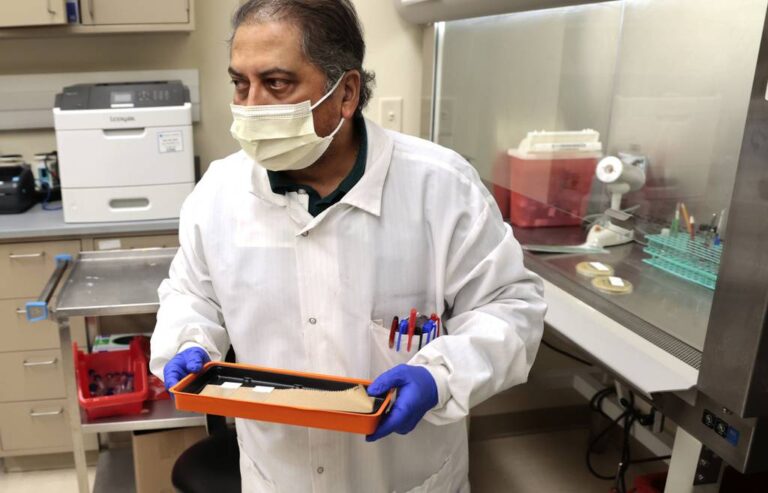The popularity of HBO’s video game adaptation “The Last of Us,” set in a post-apocalyptic United States ravaged by a pandemic caused by a parasitic fungus, has evoked fears for some of a similar mass infection on the heels of COVID-19.
Now, the spread of a deadly fungus known as Candida auris across the United States has only intensified the public’s uneasiness. But health experts and doctors say that the multidrug-resistant yeast — a type of fungus — does not normally affect healthy people.
“We do need to be vigilant and, because we still are at a point of where things aren’t totally out of hand, then maybe we can curb this before it gets too crazy,” said Sharon Welbel, director of hospital epidemiology and infection control for Cook County Health Department. “But the bottom line is, people don’t need to panic.”
The fungus can be serious in people who are immunocompromised, on ventilators or really ill in hospitals, Dr. Allison Arwady, commissioner of the Chicago Department of Public Health, said in an unrelated Facebook Q&A on Tuesday. Given that it can live on surfaces for several weeks, C. auris is spread primarily in health care settings and nursing homes through contact with affected patients and contaminated surfaces or equipment.
Though the first case of C. auris occurred in the United States in 2013, the fungus was first identified as a significant public health threat in 2016, particularly in New York and Illinois. According to a C. auris tracker on the Centers for Disease Control and Prevention website, Illinois had 276 clinical cases between January and December 2022 out of the 2,377 clinical cases reported across the United States in that same period. Illinois had the fifth most cases, behind Nevada, California, Florida and New York.
As of Thursday, there have been 37 cases of C. auris reported in the state this year, according to the Illinois Department of Public Health.
Symptoms related to a C. auris infection include fever and chills that don’t improve after antibiotic treatment for a suspected bacterial infection, according to the CDC.
“Candida in general, including Candida auris, can cause bloodstream infections, urinary tract infections and skin and skin structure infections,” Welbel said.
The CDC says that 30% to 60% of patients infected with C. auris die, though this is based on information collected from a limited number of people.
A study published Tuesday by the Annals of Internal Medicine and conducted by CDC researchers determined that C. auris spread particularly fast across the United States during the COVID-19 pandemic. In 2021, 1,471 clinical cases were reported, a significant increase from 476 cases in 2019.
“If you think about the pandemic, a lot of people got sick and then went to the hospital,” said Daniel Raudabaugh, a senior research scientist at Purdue University’s Aime Lab. “So it kind of makes sense that you see a higher outbreak (of C. auris) because there’s more people that go to the hospitals and it’s more likely that people are getting infected.”
Arwady also referred to the first months of the pandemic, when a broken supply chain caused a stark decrease in the availability of disposable masks, gloves and gowns for health care workers, creating the need to reuse much of this equipment.
“During COVID, where there was a lot of stress on the health care system, there may have been some more reuse of personal protective equipment early on when those supply chains were disrupted,” she said. “Not surprisingly, the spread of these organisms — that can be very hard to treat or are drug-resistant or can spread in health care — we’ve seen some more of that.”

Changes in cleaning and disinfection practices during the pandemic may also have contributed to the spread of C. auris in health care settings. Additionally, COVID-19 affects the immune system and treatments, such as steroids, can weaken the body’s defenses against fungi, which likely has significantly increased the risk for fungal infections, according to the CDC.
Arwady said that, before working at the CDPH, she was assigned by the CDC to the Illinois Department of Public Health. During her time there, she joined the yearslong fight against C. auris alongside local health departments, long-term care facilities and academic researchers.
“In Illinois, where we had it early, even during COVID, we’ve had very good success in containing it,” she said. “The good news is that while there’s been a lot of focus on Candida auris — and there should be, it’s a real concern — we are known here in Chicago and Illinois as being one of the places that detected it early, has put a lot of resources into controlling it and, even during COVID, have managed to keep it under reasonably good control.”
Welbel said knowledge about the fungus has been disseminated well in Illinois, which has allowed health care facilities to screen for C. auris and take measures — such as isolation precautions and cleaning protocols — so it doesn’t transmit between patients.
Some ways to prevent these infections include good hand-washing habits and sanitizing procedures in health care facilities. The Environmental Protection Agency, Welbel said, has released “List P,” which enumerates approved disinfectant products for C. auris.
“The biggest concern is the resistance” to treatment, Welbel said.
According to the CDC, some C. auris infections have been resistant to all three types of antifungal medicines. One reason why it’s particularly difficult to find effective antifungal treatments, researchers say, lies within the genetic similarities between fungi and animals — including humans.
“Fungi are more closely related to us than plants,” said Raudabaugh, the researcher from Purdue. “So, it just limits our ability to find differences that we can target to kill (fungi) and not hurt us.”
But there is a silver lining. Treatments can target those characteristics that are different between fungi and humans, Welbel said. “Actual fungi have got different properties to it that we can use antifungal agents to attack and that aren’t similar to human cells,” she said. “So (antifungal treatments) can attack the cell walls and inhibit certain processes that (fungi) need to live.”
Raudabaugh also pointed out that high body temperatures often protect humans from fungal infections. But many people believe warming global temperatures are increasing fungal resistance to hotter conditions, thus making people more vulnerable.
“So, realistically, we just need to put more resources into trying to find new antifungals,” he said.
Chicago Tribune’s Lisa Schencker contributed.







